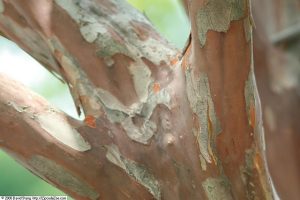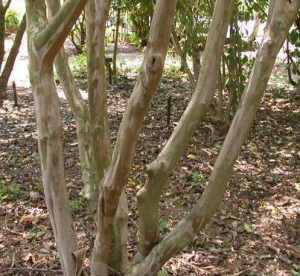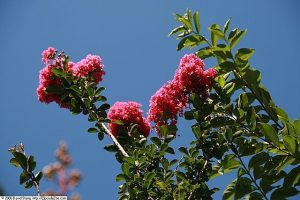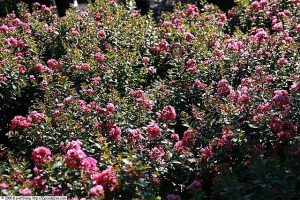One of the most beloved, iconic trees of the south, crape myrtle is prized for its long, vibrant bloom period in the height of summer heat. Commonly called the “lilac of the South,” the spelling of this tree is a litmus test of geographic origins. Crepe myrtle is the most commonly accepted “southern” spelling; north of some unspecified crepe-myrtle line, it becomes crape myrtle. But despite the difference in spelling, this selection consistently offers clouds of blooms, attractive exfoliating bark, colorful leaf color in fall, and a variety of sizes ranging from 20” shrubs to 30’ trees. In fact, this multi-stemmed deciduous plant is considered either a tree or a shrub depending on size. Cultivar heights range from dwarf to semi-dwarf, medium to tall. The exfoliating bark peels away to expose a trunk which ranges in color from many handsome shades of brown to gray to pink. This bark is especially noticeable in the winter months when the tree is leafless, giving crape myrtle its prized four-season interest.


Lagerstroemia is a genus of about 40 species of deciduous and evergreen shrubs and trees from warm-temperate to tropical areas of Asia to Australia. The genus name honors Magnus von Lagerstroem (1691-1759), Swedish botanist, Director of the Swedish East Indies Company, and friend of Linnaeus. The most common species in the United States is Lagerstroemia indica. Although native to China and Korea, the species name (indica) indicates that the plant originated on the Indian subcontinent. When Europeans first encountered crape myrtle in India, they assumed it was native to that location. It was introduced into South Carolina in the late 1700s. L. fauriei, native to Japan, is another species found in the United States. Hybrids of the two species generally produce excellent selections.
PLANTING
The ideal planting site is in well-prepared, well-drained soil, with full sun exposure and good air circulation. Crape myrtles planted in partial or full shade will have reduced flowering and increased disease susceptibility. The plant will tolerate slightly alkaline to acidic (5.0 to 6.5 pH) clay and other soil textures. Although drought-tolerant, it requires irrigation until it becomes well-established (approximately two years).
FERTILIZATION
Light fertilization is best; heavy fertilization can increase foliage production at the expense of flowering. Light applications of a complete fertilizer in spring after leaves have appeared and in summer are adequate. A complete general-purpose garden fertilizer — such as 8-8-8, 10-10-10, 12-4-8 or 16-4-8 — is ideal. For newly–planted small plants (1-gallon size), apply 1 teaspoon of fertilizer along the perimeter of the planting hole monthly from March to August. Larger, established plants will benefit from one broadcast application of fertilizer in spring after the leaves have appeared. The best time to fertilize is just before a rain. Otherwise, water in the fertilizer after application. It is not necessary to remove mulch when fertilizing.
PRUNING
Flowers are produced on new growth. On smaller plants, a second bloom can be encouraged by pruning flowers immediately after they fade. Severe pruning of crape myrtles has become a common practice to maintain shrub size. Chopping off the tops of crape myrtles, known as “topping” or “Crape Murder” ruins the natural, graceful effect of the plant. Many dwarf and semi-dwarf cultivars are now available, making it possible for the homeowner to have the desired plant size while maintaining the natural branching effect. The best way to maintain a crape myrtle is to plant an appropriate cultivar that will grow to the height and spread desired at maturity.
Corrective pruning should be done to remove damaged or dead branches when a problem is detected. Otherwise, prune while the plant is dormant (winter or early spring) to remove lateral branches, small twigs, or branches in the center of the plant to open more space for sun and air movement.
To develop a tree shape, remove all but three to five of the strongest trunks at ground level. As these trunks mature, remove lower, lateral branches (aka ‘limbing-up’) to one-third or halfway up the height of the plant. Remove branches that are crossing or rubbing against each other as well as shoots growing into the center of the canopy. Make cuts to a side branch or close to the trunk. As the tree grows taller, remove lower branches as needed. Remove any future growth from the ground to retain the desired tree shape. Basal sprouting may occur whether the tree has been pruned or not. When possible, pull these sprouts out while still succulent. Wait a growing season or two before grooming and shaping tree forms to allow them to get established and build reserves.
For more information on the pruning of crape myrtle, refer to the Clemson Cooperative Extension, HGIC 1009, Crape Myrtle Pruning
When a large crape myrtle is in a spot where a low, compact plant is desired, there are two options: (1) dig up the offending specimen and then plant a dwarf or smaller cultivar that requires little to no maintenance, or (2) prune the stems back to about six inches above the ground each year. Severe pruning will not kill or injure a healthy crape myrtle.
PROPAGATION
Crape myrtle is propagated easily from semi-hard wood cuttings taken during spring and summer. Take 6-8” cuttings from new growth, leaving three to four nodes per cutting and several leaves. Rooting hormone is generally not necessary, and cuttings should root in three to four weeks. Place cuttings in well-drained rooting medium in a shaded area; keep them moist by enclosing them in a clear plastic bag. The young rooted plants can be transplanted to their permanent location during the fall and winter. (Note: It’s illegal to propagate plants that are still under patent.)
DISEASES AND PESTS
Crape myrtles are susceptible to many problems including: powdery mildew, sooty mold, black spot, tip blight, Cercospera leaf spot, and root rot. Aphids and Florida wax scale, also potential pests, occur relatively infrequently.
Powdery mildew is a common disease in early summer during hot, dry weather. It appears as a white, powdery coating or spots on leaves and flower buds. Treatment is rarely needed, although heavy infections of the flower buds can cause them to abort.
Sooty mold is an unsightly superficial, dark brown or black coating on leaves and stems that can be removed by rubbing. It is the result of a fungus growing on honey-dew excretions made by insects such as aphids. Plant vigor may be decreased because of the reduction of photosynthesis in the leaves due to shading.
Tip blight results from a fungus that causes leaves near the tips of the tree branches to turn brown in spring or summer. Look closely at the infected foliage to see the small black spore-bearing bodies.
Cercospora leaf spot is a fungus disease that occurs more in mid-to-late summer, particularly when weather is rainy. Dark spots show up on the leaves, which then turn yellow or orange and drop. Even though trees may lose a large portion of their leaves, there are no long-term, serious health effects. By the time you see this disease, spraying is not effective.
Crape myrtle is resistant to deer.
SELECTION CRITERIA
Choosing a crape myrtle is not just a matter of selecting a particular color. The desired mature size is a major consideration. The garden rule of “right plant, right place” is expanded to “right size, right place.” Because crape myrtles are best if not pruned, size selection becomes paramount. James Hodges of the Clemson Extension advises the following steps for choosing well-adapted, suitably-sized plants in desirable colors:
- Research cultivar information on crape myrtles and take it with you for the purchasing decision.
- Know the potential mature size (small shrub, medium shrub, or various sized trees) of the cultivars under consideration.
- For cold-hardiness, select cultivars that are classified as Zone 7 or lower according to the USDA Plant Hardiness Zone Map.
- Choose cultivars that are resistant to powdery mildew and aphid insects; treating these problems is often difficult on larger plants.
- Select named cultivars and keep these records so you can match additional plants in the future; this will also help you identify good and poor cultivars based on your site.
NATIONAL ARBORETUM CULTIVARS
Many of the successful crape myrtle cultivars have been developed by the National Arboretum research and breeding programs. Many of these hybrids are named for Indian tribes, which makes it easy for gardeners to remember and to identify particular selections. These cultivars were also developed for mildew resistance. The mature heights of these trees vary by temperature, i.e., they may grow to the high end of the stated range (or more) in southern climates but remain much smaller in colder climates. As you will see from the following list, size at maturity is significantly impacted by temperature. The following list represents some of the cultivars developed at the National Arboretum; all are recommended for Zone 7 or lower. All have dark green foliage that offers fall color, exfoliating bark, and terminal inflorescences (panicles) of flowers.

Lagerstroemia ‘Natchez’ grows 4’ to 21’ tall; orange to red fall color; dark cinnamon bark; and 6-12” long white flowers.
Lagerstroemia indica ‘Muskogee’ grows to 12’ to 25’ tall; reddish-orange fall color; gray to tan bark; up to 10” long light lavender-pink flowers.
Laerstroemia ‘Yuma’ grows 6′ to 20′ tall; dull yellow-orange fall color; grayish-brown bark; up to 14″ long bicolored lavender flowers.
Lagerstroemia ‘Choctaw’ grows 3’ to 18’ tall; bronze to maroon fall color; dark bark shows light brown exfoliation; 7-17″ long bright pink flowers.


Lagerstroemia ‘Apalachee’ grows 2’ to 12’ tall; dull orange to dark red fall color; cinnamon to gray bark; 5-9” long light lavender flowers.
Lagerstroemia ‘Tuscarora’ grows 2’ to 16’ tall; reddish-orange fall color; mottled tan bark; 6-12” long dark coral-pink flowers.
Lagerstroemia indica ‘Hopi’ grows 4’ to 11’ tall; reddish-orange fall color; grayish-brown bark; 6-7” long light pink flowers.
Lagerstroemia ‘Comanche’ grows 3’ to 11’ tall; dark orange to dark reddish-purple fall color; mottled sandlewood bark; 6-9” coral-pink flowers.
Lagerstroemia ‘Acoma’ grows 2’ to 10’ tall; dull red or reddish-purple fall color; gray bark; 6-7” long white flowers.
Lagerstroemia ‘Potomac’ grows 2’ to 10’ tall; dull orange to dark red fall color; grayish bark; 6-8” long medium pink flowers.
Lagerstroemia ‘Tonto’ grows 2’ to 11’ tall; dull red to reddish-purple fall color; beige bark; 6-7” long bright magenta flowers.
DWARF CULTIVARS
The RAZZLE DAZZLE SERIES® of six dwarf plants was developed at a Michael Dirr breeding program at the Center for Applied Nursery Research in Dearing, Georgia. These deciduous, multi-stemmed cultivars are noted for ease of care, excellent flower colors, handsome foliage, compact habit, and good disease resistance. If spent flowers are promptly deadheaded, additional flowers will continue to bloom into fall. Flowers give way to round seed capsules which often persist well into winter.
- Lagerstroemia indica ‘Gamad I’ CHERRY DAZZLE grows 3′ to 5’ tall and wide; full sun to part sun; burgundy-red fall color; grayish-brown bark; cherry-red flowers.
- Lagerstroemia ‘Gamad V’ DAZZLE ME PINK grows 3′ to 4’ tall and wide; full sun to part sun; burgundy-red fall color; grayish-brown bark; bubblegum-pink flowers.
- Lagerstroemia ‘Gamad VI’ BERRY DAZZLE grows 3′ to 4’ tall and wide; full sun; burgundy new foliage; early bloomer; fuchsia-purple flowers.
- Lagerstroemia ‘Gamad VII’ SWEETHEART DAZZLE grows 2′ to 3’ tall and 4′ to 5’ wide; full sun to full shade; beautiful pink flowers.
- Lagerstroemia ‘PllLAG-1’ DIAMOND DAZZLE grows 3′ to 4’ tall and wide; full sun; pure white flowers.
- Lagerstroemia ‘PllLAG-2’ STRAWBERRY DAZZLE grows 4′ to 5’ tall and wide; full sun; neon-pink flowers.
The following are deciduous, mildew-resistant dwarf crape myrtle cultivars developed by the National Arboretum in Washington, D.C.

- Lagerstroemia ‘Pocomoke’ grows 2’ to 5’ tall; glossy, dark green leaves emerge maroon in spring, turn dark green in late spring, and finally turn bronze-red in fall; gray to tan bark; deep rose-pink flowers.
- Lagerstroemia ‘Chickasaw’ is a dwarf-mounded shrub that grows only 20″ tall by 26″ wide over a period of 7 years; pinkish-lavender flowers from midsummer to frost.
MIDSIZED CRAPE MYRTLES
Micheal Dirr has also developed a Barnyard® series of midsized crape myrtles, including:
- Lagerstroemia x ‘Gamad VIII’ Pink Pig grows 6′ to 10’ tall and 5’ wide; full sun; burgundy buds followed by large, soft, pale pink flowers.
- Lagerstroemia x ‘Gamad IX’ Purple Cow grows 6′ to 10’ tall and 5’ wide; full sun to part sun, deep purple flowers.
- Lagerstroemia ‘PllLAG III’ Red Rooster grows 8′ to 10’ tall and 5’ wide; full sun; foliage starts as burgundy in spring before turning dark green; brilliant red flowers.
Note that, as with any new cultivars, an introductory period in the general market will provide more information on cold-hardiness, disease, desired moisture levels, and sunlight requirements.
WARNINGS
During the long blooming season, old flowers drop out of the trees. This is a nuisance when trees are planted near patios, pools, and parked cars. Honeydew drops from aphids may also stick on cars or patio furniture.
A common problem with crape myrtles is injury from the careless use of mowers and string trimmers around the base of these thin-barked trees. To prevent this type of damage, do not allow grass to grow within a foot of the trunk. To deter weeds, cover the area around the tree base with about 4” of mulch pulled back slightly from the trunk.
USES IN THE LANDSCAPE
Because of the great variety in size of various cultivars now offered, crape myrtles can be planted as specimen trees or as a brilliant border of color in group plantings. Midsized cultivars can be used in smaller landscapes. Dwarf varieties offer a brilliant, long-lasting color to perennial beds or to foundation plantings. They can even be used in planters and placed on decks and patios. The color palette is broad and beautiful. The crape myrtle’s historical presence in southern gardens will become even more prevalent now that it’s been given so many new looks!
SOURCES
At top of article, photo of Lagerstroemia ‘Muskogee’ by David J. Lang
“Lagerstroemia-indica,” https://plants.ces.ncsu.edu/plants/all/lagerstroemia-indica/
“Crape Myrtle Pruning, https://hgic.clemson.edu/factsheet/crape-myrtle-pruning/
“Star Gardener: Not all Crape Myrtles are Created Equal,” http://easthamptonstar.com/Arts/4/Star-Gardener-Not-All-Crape-Myrtles-Are-Created-Equal
“Choosing Right Crepe Myrtles,” http://www.indexjournal.com/lifestyles/columnists/clemson-extension/clemson-extension-choosing-right-crape-myrtles/article_ec8198a4-7e4a-5a81-96b6-0332e5a995b5.html
“Crape Myrtle,” https://hgic.clemson.edu/factsheet/crape-myrtle/
USDA Plant Hardiness Zone Map, http://planthardiness.ars.usda.gov/PHZMWeb/
“Crape Myrtle Culture – University of Georgia,” https://secure.caes.uga.edu/extension/publications/files/pdf/C%20944_5.PDF
Clemson University’s HGIC plant search website, https://hgic.clemson.edu/
Gardener’s Confidence Collection, https://gardenersconfidence.com/plants/red-rooster-crapemyrtle
Missouri Botanical Garden Plant Finder, http://www.missouribotanicalgarden.org/PlantFinder/PlantFinderDetails.aspx?taxonid=250246&isprofile=1&basic=lagerstroemia